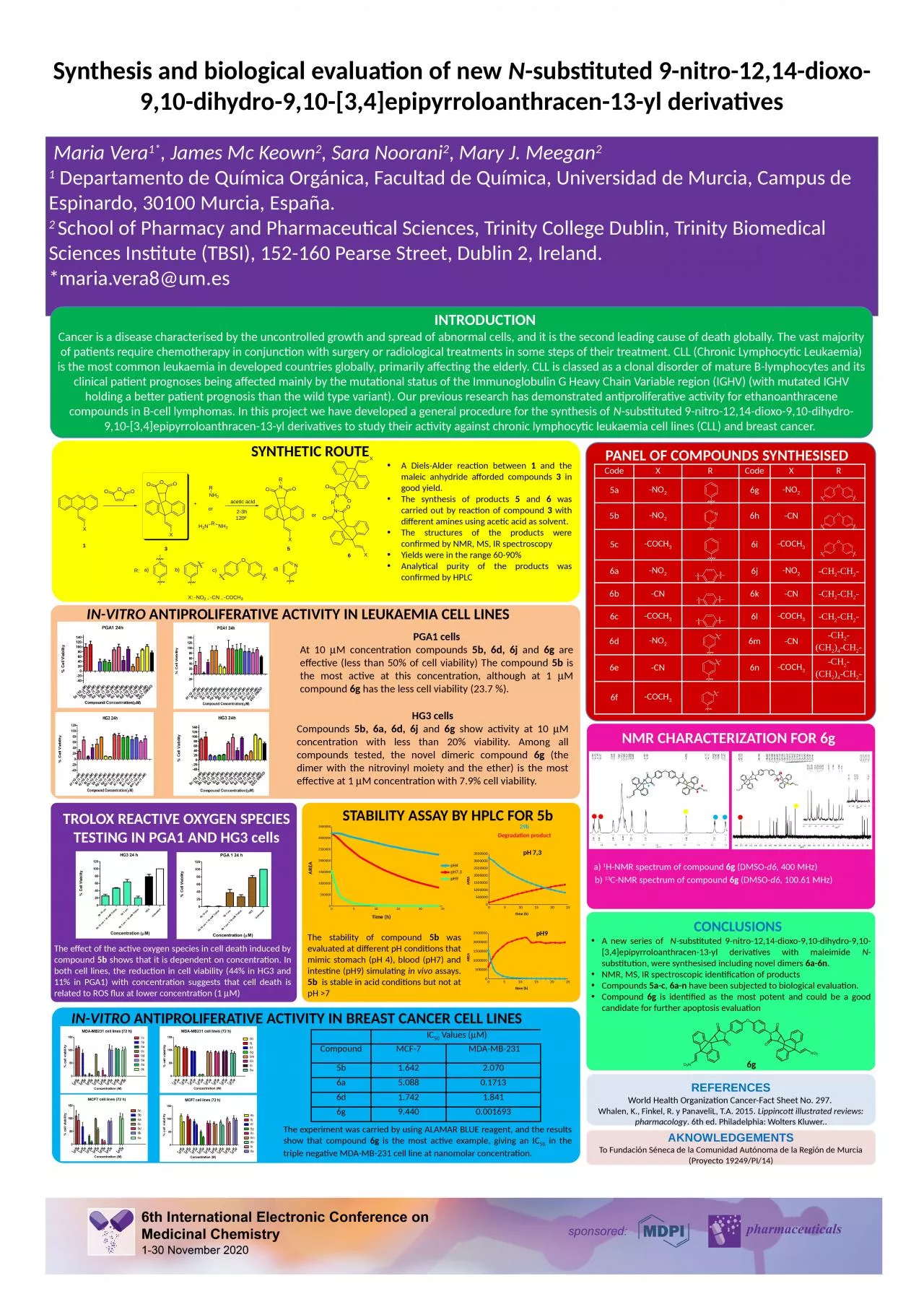

N substituted 9nitro1214dioxo910dihydro91034epipyrroloanthracen13yl derivatives Maria Vera 1 James Mc Keown 2 Sara Noorani 2 Mary J Meegan 2 1 Departamento ID: 1043872
Download Presentation The PPT/PDF document "Synthesis and biological evaluation of n..." is the property of its rightful owner. Permission is granted to download and print the materials on this web site for personal, non-commercial use only, and to display it on your personal computer provided you do not modify the materials and that you retain all copyright notices contained in the materials. By downloading content from our website, you accept the terms of this agreement.
1. Synthesis and biological evaluation of new N-substituted 9-nitro-12,14-dioxo-9,10-dihydro-9,10-[3,4]epipyrroloanthracen-13-yl derivatives Maria Vera1*, James Mc Keown2, Sara Noorani2, Mary J. Meegan2 1 Departamento de Química Orgánica, Facultad de Química, Universidad de Murcia, Campus de Espinardo, 30100 Murcia, España. 2 School of Pharmacy and Pharmaceutical Sciences, Trinity College Dublin, Trinity Biomedical Sciences Institute (TBSI), 152-160 Pearse Street, Dublin 2, Ireland.*maria.vera8@um.es PANEL OF COMPOUNDS SYNTHESISEDCodeXRCodeXR5a-NO26g-NO25b-NO26h-CN5c-COCH36i-COCH36a-NO26j-NO2-CH2-CH2-6b-CN6k-CN-CH2-CH2-6c-COCH36l-COCH3-CH2-CH2-6d-NO26m-CN-CH2-(CH2)4-CH2-6e-CN6n-COCH3-CH2-(CH2)4-CH2-6f-COCH3Cancer is a disease characterised by the uncontrolled growth and spread of abnormal cells, and it is the second leading cause of death globally. The vast majority of patients require chemotherapy in conjunction with surgery or radiological treatments in some steps of their treatment. CLL (Chronic Lymphocytic Leukaemia) is the most common leukaemia in developed countries globally, primarily affecting the elderly. CLL is classed as a clonal disorder of mature B-lymphocytes and its clinical patient prognoses being affected mainly by the mutational status of the Immunoglobulin G Heavy Chain Variable region (IGHV) (with mutated IGHV holding a better patient prognosis than the wild type variant). Our previous research has demonstrated antiproliferative activity for ethanoanthracene compounds in B-cell lymphomas. In this project we have developed a general procedure for the synthesis of N-substituted 9-nitro-12,14-dioxo-9,10-dihydro-9,10-[3,4]epipyrroloanthracen-13-yl derivatives to study their activity against chronic lymphocytic leukaemia cell lines (CLL) and breast cancer. INTRODUCTIONIN-VITRO ANTIPROLIFERATIVE ACTIVITY IN LEUKAEMIA CELL LINES HG3 cellsCompounds 5b, 6a, 6d, 6j and 6g show activity at 10 mM concentration with less than 20% viability. Among all compounds tested, the novel dimeric compound 6g (the dimer with the nitrovinyl moiety and the ether) is the most effective at 1 mM concentration with 7.9% cell viability.PGA1 cellsAt 10 mM concentration compounds 5b, 6d, 6j and 6g are effective (less than 50% of cell viability) The compound 5b is the most active at this concentration, although at 1 mM compound 6g has the less cell viability (23.7 %). IC50 Values (mM) Compound MCF-7 MDA-MB-2315b1.6422.0706a5.0880.17136d1.7421.8416g9.4400.001693The experiment was carried by using ALAMAR BLUE reagent, and the results show that compound 6g is the most active example, giving an IC50 in the triple negative MDA-MB-231 cell line at nanomolar concentration.IN-VITRO ANTIPROLIFERATIVE ACTIVITY IN BREAST CANCER CELL LINES AKNOWLEDGEMENTSTo Fundación Séneca de la Comunidad Autónoma de la Región de Murcia (Proyecto 19249/PI/14)REFERENCESWorld Health Organization Cancer-Fact Sheet No. 297. Whalen, K., Finkel, R. y PanaveliL, T.A. 2015. Lippincott illustrated reviews: pharmacology. 6th ed. Philadelphia: Wolters Kluwer..SYNTHETIC ROUTEA Diels-Alder reaction between 1 and the maleic anhydride afforded compounds 3 in good yield.The synthesis of products 5 and 6 was carried out by reaction of compound 3 with different amines using acetic acid as solvent.The structures of the products were confirmed by NMR, MS, IR spectroscopyYields were in the range 60-90%Analytical purity of the products was confirmed by HPLCTROLOX REACTIVE OXYGEN SPECIES TESTING IN PGA1 AND HG3 cellsThe effect of the active oxygen species in cell death induced by compound 5b shows that it is dependent on concentration. In both cell lines, the reduction in cell viability (44% in HG3 and 11% in PGA1) with concentration suggests that cell death is related to ROS flux at lower concentration (1 mM)CONCLUSIONSA new series of N-substituted 9-nitro-12,14-dioxo-9,10-dihydro-9,10-[3,4]epipyrroloanthracen-13-yl derivatives with maleimide N-substitution, were synthesised including novel dimers 6a-6n.NMR, MS, IR spectroscopic identification of products Compounds 5a-c, 6a-n have been subjected to biological evaluation.Compound 6g is identified as the most potent and could be a good candidate for further apoptosis evaluation6gSTABILITY ASSAY BY HPLC FOR 5b29bDegradation productThe stability of compound 5b was evaluated at different pH conditions that mimic stomach (pH 4), blood (pH7) and intestine (pH9) simulating in vivo assays. 5b is stable in acid conditions but not at pH >7NMR CHARACTERIZATION FOR 6g a) 1H-NMR spectrum of compound 6g (DMSO-d6, 400 MHz) b) 13C-NMR spectrum of compound 6g (DMSO-d6, 100.61 MHz)